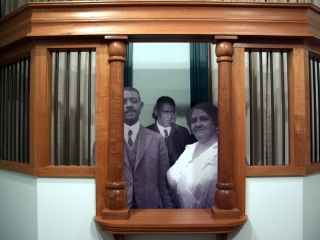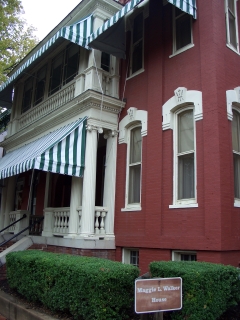NPS Website; Local Website
WHAT IS IT?
 Longtime home of Maggie Walker, an African-American female who, around the turn of the Century, led a prominent benevolent organization, started a newspaper, chartered and served as President of a Bank.
Longtime home of Maggie Walker, an African-American female who, around the turn of the Century, led a prominent benevolent organization, started a newspaper, chartered and served as President of a Bank.BEAUTY (3/10)
The Maggie Walker NHS is located in her former home, located in the Jackson Ward district of Richmond. Her redbrick townhouse stands out among its peers only because of its awning, distinguished by green and white vertical stripes. Her house would look in-place in countless cities up and down the east coast. The Victorian-era townhouses in the Jackson Ward district, notable as “the birthplace of African American entrepreneurship”, would win no prize for beautiful architecture.
HISTORICAL INTEREST (4/10)
Who was America’s “Greatest Generation”? In his best-selling 1998 book, Tom Brokaw lauded those Americans born in the 1920’s. Terrific choice. It would also be impossible to forget the founding fathers: the generation that fought the Revolutionary War, wrote the Declaration of Independence and the Constitution and changed western society forever.
We would also nominate the generation of African-Americans born from 1850-1870. They rose from slavery and, in the face of extreme Reconstruction-era violence and lynchings, created and built societal infrastructures (banks, schools, churches, newspapers, etc…) from the ground up. NPS sites honor George Washington Carver, Mary-McLeod Bethune, Booker T. Washington and Paul Laurence Dunbar. W.E.B. DuBois supporters are still waiting for federal recognition.
Maggie Walker was one of the most famous African-American females of this pioneering generation. She was born in 1867, just two years after the Civil War’s end, to a former slave in Richmond, the recently conquered capital of the Confederacy. In 1899, she became head of an important benevolent society, the Order of St. Luke. In 1903, Walker founded a Richmond Bank that still holds the distinction of the oldest continually operated African-American Bank in the United States.
CROWDS (6/10)
Intuition tells us that the Site does not get many walk-in customers, the majority of visitors being area school kids. For the Ranger to give us a personal tour of the house, she had to abandon her post at the front desk and lock the Park entrance door. She did not seem too bothered by her necessary choice. Odds were that no one else was visiting the Site that day.
EASE OF USE/ACCESS (5/5)
 The Maggie Walker NHS is located near downtown Richmond at the corner of 2nd and W. Leigh Street. There should be ample street parking directly in front of the Site’s entrance at 600 N. 2nd. The House is about 10 blocks from both the Virginia State Capitol and the Richmond NBP Visitor Center at the Tredegar Iron Works.
The Maggie Walker NHS is located near downtown Richmond at the corner of 2nd and W. Leigh Street. There should be ample street parking directly in front of the Site’s entrance at 600 N. 2nd. The House is about 10 blocks from both the Virginia State Capitol and the Richmond NBP Visitor Center at the Tredegar Iron Works.From both I-95 and I-64 take the Chamberlayne Parkway exit. It’s Exit 76A from the north/west and 76 B from the south/east.
CONCESSIONS/BOOKSTORE (3/5)
The bookstore carries a nice selection of African-American women’s history titles and two titles about female Yankee spies living in Richmond during the Civil War. We especially liked the poster reprint of the “Prominent Black Americans at the Turn of the Century” picture montage that hangs in Maggie Walker’s living room.
COSTS (5/5)
Entry is free. You must visit the House accompanied by a Ranger. The guided tour is gratis.
RANGER/GUIDE TO TOURIST RATIO (5/5)
Just the Ranger and us.
TOURS/CLASSES (6/10)
As much as we enjoyed the introductory video, the new museum displays, our guided tour, the erudite Ranger and the house, we still were less than excited about Maggie Walker’s life and accomplishments. Regardless of how you slice them, banking, benevolent societies and newspapers equal boring.
FUN (3/10)
A free, private guided house tour is always nice, especially when it involves learning about someone you had never heard of.
WOULD WE RECOMMEND? (3/10)
Maggie Walker’s inspirational and somewhat bizarre story (read about the sensational murder allegations somewhere else) can be easily appreciated without traveling to her Richmond house. The house’s biggest draw is the idea that most of the late 19th, early 20th Century’s great African Americans spent some time in Walker’s parlor.
TOTAL 43/80
www.usa-c2c.com
© 2005